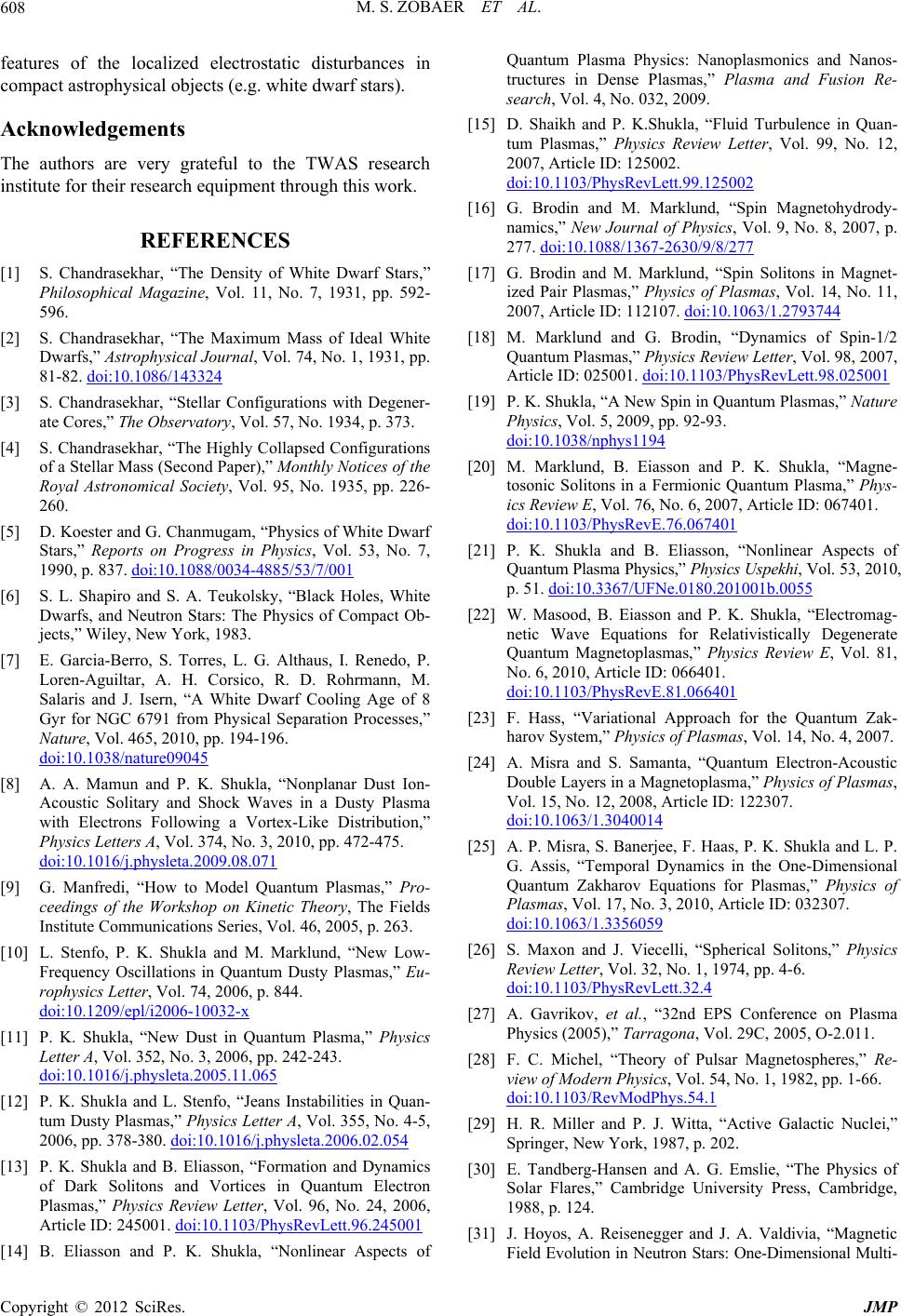
M. S. ZOBAER ET AL.
608
features of the localized electrostatic disturbances in
compact astrophysical objects (e.g. white dwarf stars).
Acknowledgements
The authors are very grateful to the TWAS research
institute for their research equipment through this work.
REFERENCES
[1] S. Chandrasekhar, “The Density of White Dwarf Stars,”
Philosophical Magazine, Vol. 11, No. 7, 1931, pp. 592-
596.
[2] S. Chandrasekhar, “The Maximum Mass of Ideal White
Dwarfs,” Astrophysical Journal, Vol. 74, No. 1, 1931, pp.
81-82. doi:10.1086/143324
[3] S. Chandrasekhar, “Stellar Configurations with Degener-
ate Cores,” The Observatory, Vol. 57, No. 1934, p. 373.
[4] S. Chandrasekhar, “The Highly Collapsed Configurations
nd Paper),” Monthly Notices of t
ciety, Vol. 95, No. 1935, pp. 226-
Stars,” Reports on Progress in Physics, Vol. 53, No.
1990, p. 837. d 3/7/001
of a Stellar Mass (Seco
Royal Astronomical So
he
260.
[5] D. Koester and G. Chanmugam, “Physics of White Dwarf
7,
oi:10.1088/0034-4885/5
[6] S. L. Shapiro lack Holes, White
rcia-Berro, S. Torres, L. G. Althaus, I. Renedo, P
ysical Separation Processes,”
and S. A. Teukolsky, “B
Dwarfs, and Neutron Stars: The Physics of Compact Ob-
jects,” Wiley, New York, 1983.
[7] E. Ga.
Loren-Aguiltar, A. H. Corsico, R. D. Rohrmann, M.
Salaris and J. Isern, “A White Dwarf Cooling Age of 8
Gyr for NGC 6791 from Ph
Nature, Vol. 465, 2010, pp. 194-196.
doi:10.1038/nature09045
[8] A. A. Mamun and P. K. Shukla, “Nonplanar Dust Ion-
Acoustic Solitary and Shock Waves in a Dusty Plasma
with Electrons Following a Vortex-Like Distribution,”
Physics Letters A, Vol. 374, No. 3, 2010, pp. 472-475.
doi:10.1016/j.physleta.2009.08.071
[9] G. Manfredi, “How to Model Quantum Plasmas,” Pro-
ceedings of the Workshop on Kinetic Theory, The Fields
Institute Communications Series, Vol. 46, 2005, p. 263.
[10] L. Stenfo, P. K. Shukla and M. Marklund, “New Low-
Frequency Oscillations in Quantum Dusty Plasmas,” Eu-
rophysics Letter, Vol. 74, 2006, p. 844.
doi:10.1209/epl/i2006-10032-x
[11] P. K. Shukla, “New Dust in Quantum Plasma,” Physics
Letter A, Vol. 352, No. 3, 2006, pp. 242-243.
doi:10.1016/j.physleta.2005.11.065
[12] P. K. Shukla and L. Stenfo, “Jeans Instabilities in Quan-
tum Dusty Plasmas,” Physics Letter A, Vol. 355, No. 4-5,
2006, pp. 378-380. doi:10.1016/j.physleta.2006.02.054
[13] P. K. Shukla and B. Eliasson, “Formation and Dynamics
of Dark Solitons and Vortices in Quantum Electr
Plasmas,” Physics Review Letter, V
on
ol. 96, No. 24, 2006,
Article ID: 245001. doi:10.1103/PhysRevLett.96.245001
[14] B. Eliasson and P. K. Shukla, “Nonlinear Aspects of
Quantum Plasma Physics: Nanoplasmonics and Nanos-
bulence in Quan-
, Vol. 99, No. 12,
tructures in Dense Plasmas,” Plasma and Fusion Re-
search, Vol. 4, No. 032, 2009.
[15] D. Shaikh and P. K.Shukla, “Fluid Tur
tum Plasmas,” Physics Review Letter
2007, Article ID: 125002.
doi:10.1103/PhysRevLett.99.125002
[16] G. Brodin and M. Marklund, “Spin Magnetohydrody-
namics,” New Journal of Physics, Vol. 9, No. 8, 2007, p.
277. doi:10.1088/1367-2630/9/8/277
[17] G. Brodin and M. Marklund, “Spin Solitons in Magnet-
ized Pair Plasmas,” Physics of Plasmas, Vol. 14, No. 11,
2007, Article ID: 112107. doi:10.1063/1.2793744
[18] M. Marklund and G. Brodin, “Dynamics of Spin-1/2
Quantum Plasmas,” Physics Review Letter, Vol. 98, 2007,
Article ID: 025001. doi:10.1103/PhysRevLett.98.025001
[19] P. K. Shukla, “A New Spin in Quantum Plasmas,” Nature
Physics, Vol. 5, 2009, pp. 92-93.
doi:10.1038/nphys1194
[20] M. Marklund, B. Eiasson and P. K. Shukla, “Magne-
tosonic Solitons in a Fermionic Quantum Plasma,” Phys-
ics Review E, Vol. 76, No. 6, 2007, Article ID: 067401.
doi:10.1103/PhysRevE.76.067401
[21] P. K. Shukla and B. Eliasson, “Nonlinear Aspects of
Quantum Plasma Physics,” Physics Uspekhi, Vol. 53, 2010,
p. 51. doi:10.3367/UFNe.0180.201001b.0055
ol. 81,
[22] W. Masood, B. Eiasson and P. K. Shukla, “Electromag-
netic Wave Equations for Relativistically Degenerate
Quantum Magnetoplasmas,” Physics Review E, V
No. 6, 2010, Article ID: 066401.
doi:10.1103/PhysRevE.81.066401
[23] F. Hass, “Variational Approach for the Quantum Zak-
harov System,” Physics of Plasmas, Vol. 14, No. 4, 2007.
[24] A. Misra and S. Samanta, “Quan
Double Layers in a Magn
tum Electron-Acoustic
etoplasma,” Physics of Plasmas,
Vol. 15, No. 12, 2008, Article ID: 122307.
doi:10.1063/1.3040014
[25] A. P. Misra, S. Banerjee, F. Haas, P. K. Shukla and L. P
G. Assis, “Temporal Dynamics in
.
the One-Dimensional
Quantum Zakharov Equations for Plasmas,” Physics of
Plasmas, Vol. 17, No. 3, 2010, Article ID: 032307.
doi:10.1063/1.3356059
[26] S. Maxon and J. Viecelli, “Spherical Solitons,” Physics
Review Letter, Vol. 32, No. 1, 1974, pp. 4-6.
doi:10.1103/PhysRevLett.32.4
[27] A. Gavrikov, et al., “32nd EPS
Physics (2005),” Tarragona, Vol. 2
Conference on Plasma
9C, 2005, O-2.011.
[28] F. C. Michel, “Theory of Pulsar Magnetospheres,” Re-
view of Modern Physics, Vol. 54, No. 1, 1982, pp. 1-66.
doi:10.1103/RevModPhys.54.1
[29] H. R. Miller and P. J. Witta, “Active Galactic Nuclei,”
Springer, New York, 1987, p. 202.
[30] E. Tandberg-Hansen and A. G. Emslie, “The Physics of
ulti-
Solar Flares,” Cambridge University Press, Cambridge,
1988, p. 124.
[31] J. Hoyos, A. Reisenegger and J. A. Valdivia, “Magnetic
Field Evolution in Neutron Stars: One-Dimensional M
Copyright © 2012 SciRes. JMP